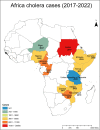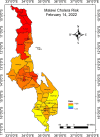Anticipatory decision-making for cholera in Malawi
- PMID: 37962395
- PMCID: PMC10746182
- DOI: 10.1128/mbio.00529-23
Anticipatory decision-making for cholera in Malawi
Abstract
Climate change raises an old disease to a new level of public health threat. The causative agent, Vibrio cholerae, native to aquatic ecosystems, is influenced by climate and weather processes. The risk of cholera is elevated in vulnerable populations lacking access to safe water and sanitation infrastructure. Predictive intelligence, employing mathematical algorithms that integrate earth observations and heuristics derived from microbiological, sociological, and weather data, can provide anticipatory decision-making capabilities to reduce the burden of cholera and save human lives. An example offered here is the recent outbreak of cholera in Malawi, predicted in advance by such algorithms.
Keywords: Malawi; cholera; remote sensing.
Conflict of interest statement
The authors declare no conflicts of interest.
Figures



Similar articles
-
Combating cholera by building predictive capabilities for pathogenic Vibrio cholerae in Yemen.Sci Rep. 2023 Feb 8;13(1):2255. doi: 10.1038/s41598-022-22946-y. Sci Rep. 2023. PMID: 36755108 Free PMC article.
-
Genomic Surveillance of Climate-Amplified Cholera Outbreak, Malawi, 2022-2023.Emerg Infect Dis. 2025 Jun;31(6):1090-1099. doi: 10.3201/eid3106.240930. Emerg Infect Dis. 2025. PMID: 40439430 Free PMC article. Review.
-
Predictive Intelligence for Cholera in Ukraine?Geohealth. 2022 Sep 1;6(9):e2022GH000681. doi: 10.1029/2022GH000681. eCollection 2022 Sep. Geohealth. 2022. PMID: 36185317 Free PMC article.
-
Cholera outbreaks in Malawi in 1998-2012: social and cultural challenges in prevention and control.J Infect Dev Ctries. 2014 Jun 11;8(6):720-6. doi: 10.3855/jidc.3506. J Infect Dev Ctries. 2014. PMID: 24916870
-
Natural Disasters and Cholera Outbreaks: Current Understanding and Future Outlook.Curr Environ Health Rep. 2017 Mar;4(1):99-107. doi: 10.1007/s40572-017-0132-5. Curr Environ Health Rep. 2017. PMID: 28130661 Review.
Cited by
-
Quantification of Climate Footprints of Vibrio vulnificus in Coastal Human Communities of the United States Gulf Coast.Geohealth. 2024 Aug 19;8(8):e2023GH001005. doi: 10.1029/2023GH001005. eCollection 2024 Aug. Geohealth. 2024. PMID: 39165476 Free PMC article.
-
Satellite-Derived, Smartphone-Delivered Geospatial Cholera Risk Information for Vulnerable Populations.Geohealth. 2024 Nov 9;8(11):e2024GH001039. doi: 10.1029/2024GH001039. eCollection 2024 Nov. Geohealth. 2024. PMID: 39524318 Free PMC article.
-
An assessment of the progress made in the implementation of the regional framework for cholera prevention and control in the WHO African region.BMJ Glob Health. 2025 Jan 22;10(1):e016168. doi: 10.1136/bmjgh-2024-016168. BMJ Glob Health. 2025. PMID: 39848635 Free PMC article. Review.
References
-
- Camacho A, Bouhenia M, Alyusfi R, Alkohlani A, Naji MAM, de Radiguès X, Abubakar AM, Almoalmi A, Seguin C, Sagrado MJ, Poncin M, McRae M, Musoke M, Rakesh A, Porten K, Haskew C, Atkins KE, Eggo RM, Azman AS, Broekhuijsen M, Saatcioglu MA, Pezzoli L, Quilici M-L, Al-Mesbahy AR, Zagaria N, Luquero FJ. 2018. Cholera epidemic in Yemen, 2016–18: an analysis of surveillance data. 6. Lancet Glob Health 6:e680–e690. doi:10.1016/S2214-109X(18)30230-4 - DOI - PMC - PubMed
-
- Hasan NA, Choi SY, Eppinger M, Clark PW, Chen A, Alam M, Haley BJ, Taviani E, Hine E, Su Q, Tallon LJ, Prosper JB, Furth K, Hoq MM, Li H, Fraser-Liggett CM, Cravioto A, Huq A, Ravel J, Cebula TA, Colwell RR. 2012. Genomic diversity of 2010 haitian cholera outbreak strains. Proc Natl Acad Sci USA 109:E2010–7. doi:10.1073/pnas.1207359109 - DOI - PMC - PubMed
MeSH terms
Grants and funding
LinkOut - more resources
Full Text Sources
Medical

